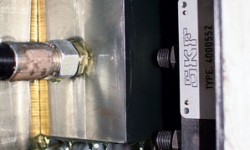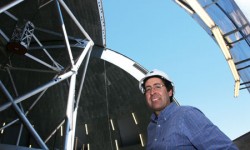
Reaching into the universe
Grantecan SA is keeping Spain at the forefront of world astronomy. At the famous Roque de los Muchachos Observatory in the Canary Islands, the outer reaches of the most distant galaxies have just been brought closer, thanks to Grantecan’s construction of the largest and most sensitive telescope on the planet.
Grantecan SA is keeping Spain at the forefront of world astronomy. At the famous Roque de los Muchachos Observatory in the Canary Islands, the outer reaches of the most distant galaxies have just been brought closer, thanks to Grantecan’s construction of the largest and most sensitive telescope on the planet.
High on theridge of a huge volcanic valley, above
a sea of clouds, a silver dome shines in the moonlight. From a slit in its surface a telescope points out into the night sky. The dome is the Observatory of Roque de los Muchachos (ORM), which stands at an altitude of 2,400 metres on the island of La Palma in Spain’s Canary Islands; the telescope is the Gran Telescopio de Canarias (GTC), the largest and most sensitive ground-based telescope on the planet. Grantecan SA is the company responsible for its creation and management.
Grantecan grew out of the Instituto de Astrofisica de Canarias (IAC), which in the late 1980s decided that a super telescope was needed to keep up with the astrophysical advances taking place at the world’s other great observatories. It was a time of spectacular growth in all fields of astronomy, yet there was no Spanish involvement at any of the world’s other large telescopes.
Initially, the institute planned a telescope with a monolithic 8-metre primary mirror, similar to other projects under way at the time. However, when global experts on large telescopes met in Tenerife, the Canary Island’s largest port city, to assess the proposal, it was decided that a groundbreaking, segmented 10-metre primary mirror should be implemented instead.
In 1994the Canarian Regional Government set up Grantecan to conduct feasibility studies into the construction of this giant. In 1996, Grantecan became
a publicly listed company, enabling the Spanish government to become a stakeholder and giving the GTC an assurance of 100 percent Spanish finance (50 percent from the Spanish government and 50 percent from the Canarian Autonomous Community) in the event that support from other countries was not forthcoming. However, the international community stepped forward, with such participants as Mexico’s National Institute for Astrophysics, Optics and Electronics, the Institute of Astronomy at the University of Mexico and, in the US, the University of Florida in Gainesville. Now approximately 10 percent of its funding comes from international sources.
Grantecan has 46 experts working on its board of directors and various divisions, including science, management, administration, quality and safety, systems, on-site, enclosure, optics, telescope, control and instruments.
The GTC project is easy to characterize in superlatives. The diameter of the GTC’s mirror is 10.4 metres, 0.4 metres larger than that of any telescope previously built (the larger a telescope’s primary mirror, the greater its light-grasping capacity). The GTC’s outstanding clarity and the sharpness of the images it produces are unrivalled in any other telescope. The mechanics, enclosure, dome, electronics and control systems are all designed to maximize the imagery and make sure it stays perfect while the telescope is tracking the target of its observation.
The detail and intensity provided wouldn’t be possible without the impeccable fluidity of movement granted by the use of hydrostatic shoe bearings.
“The hydrostatic shoe bearings are required to operate with very low friction and a very smooth motion,” says Lluis Cavaller Marqués, head of Grantecan’s Telescope Group, the division responsible for the design, construction and integration of the telescopes mechanics. “One person can move the 350-tonne telescope with the touch of a hand. This enables the telescope to track very accurately with very low vibration levels. A low vibration level improves the 350-tonne telescope with the touch of a hand. This enables quality of the image, which enables us to see more detail and to observe fainter objects more quickly.”
The Grantecantelescope is computer-controlled. To locate an object in the sky, the telescope must move around two axes: the azimuth (vertical) and the elevation. Friction-free motion in both directions is only possible through the hydrostatic bearings.
“On the azimuth axis, the weight of the telescope is supported by pressurized oil flowing from four axial pads,” explains Cavaller. “Additionally, four radial pads guide the rotation of the telescope.
“In the elevation axis there are also four pads that support the weight of the tube – approximately 150 tonnes – and four other pads that guide the rotation. Oil, pressurized at 50 bar, flows from the pads, produ-cing a uniform layer of 0.07 millimetres where the telescope moves. A system of pumps constantly feeds oil to the pads.”
Astronomers now hope to be able to get a better view of the furthest and faintest objects in the universe and discover others previously unseen. Those in the world of astrophysics couldn’t ask for anything more.
The GTC, which is scheduled to become operational sometime in 2006, will enable science “that simply cannot be done on smaller telescopes,” says astronomer Peter Hammersley, deputy of the Science division at the GTC. “When combined with its instrumentation, the GTC will offer capabilities that are not available anywhere else in the world.”
Unraveling the mysteries of the universe has always been the Holy Grail of the scientific community. On
a ridge top in the Canary Islands, below the clearest skies in Europe, Grantecan has moved the world a step closer in its quest for the ultimate answer, and, in the process, it has kept Spain at the forefront of world astronomy.
Equipped for steady floating
The construction of the world’s largest telescope, the Gran Telescopio de Canarias, has involved considerable input from SKF. SKF has equipped the telescope with 16 hydrostatic shoe bearings for the azimuth and elevation movements and has provided the complete hydraulic installation. The bearing system has had to meet extremely strict requirements: an operational life of 50 years, high movement accuracy and resistance to seismic loads. In addition, the oil-pumping systems must work to feed the external hydraulic brakes.
“SKF was selected as supplier for this system because of its know-how, having supplied the hydraulic shoe bearing systems for major telescopes such as Keck in Hawaii, VLT in Chile and Gemini in Hawaii and Chile,” says Lluis Cavaller Marqués, head of Grantecan SA’s Telescope Group.
“SKF entered this project at the very beginning, helping Grantecan with the technical specifications for the telescope’s mechanics,” says Javier Cano, SKF’s project manager for the telescope bearing system. “Each of the SKF team involved in this project is very proud of it, especially the engineers, who felt special motivation due to the technical uniqueness of this project.”








